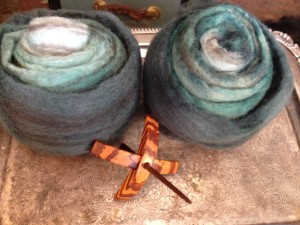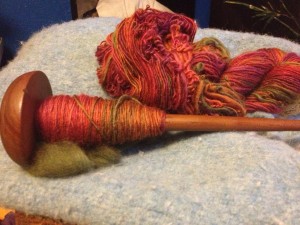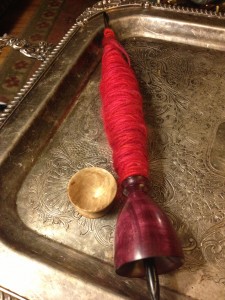This is a 27g/.95oz Jenkins Marblewood Lark on a walnut shaft. It’s my latest addition!
And the first project is 4oz of BaaBaa Huey BFL in Pine gradient.

Okay, time for a new spindle! This is my new Enid Ashcroft Mindi in Olivewood with a Walnut shaft. Weight is 25 grams.
I’ve really wanted an Olivewood spindle. We even have a chunk of it in our collection of pretty wood. I am very pleased with it. I don’t have a project for it yet, but have ordered a TB small yarn stuff sack in Iberian for this larger spindle. I am still giving the Mini and Midges a good work out. I am finally starting to feel like I have a Turkish spindle for any project. I stiil think that I need another Midge and I’d like a Midi and Maxi to round out my collection. I also like Enid’s high whorl spindles, so maybe I’ll find a need for that too. Mostly, I need to get busy knitting up some of this!
I am a fan of my Enid Ashcroft spindles. I have two Midges. They spin well and she has a nice eye for wood grain. I like the way the wood of the shaft compliments the spindle whorl. The shapes are not as elegant as my Jenkins’ turks, but I’m okay with that. I can buy Enid’s spindles and know that they are her own designs.
So this is my new Mini and the first I’ve bought directly from Enid.
This is Ovangkol with a Burmese Teak shaft. I hadn’t heard of Ovangkol, which seems to be used in making guitars. It’s beautiful wood. It’s 18 grams, 3 5/8″ whorl with a 4 5/8″ shaft. It’s very similar in size to my Jenkins’ Lark.
The Mini is lighter than the Ebony Lark but does have a similar spin. I like them both, of course! I try to keep all my turkish spindles busy, so I have too many project going right now. And I picked up another of the #1 Tom Bihn travel stuff sacks in Ultraviolet, to have a place for this new project and spindle.
Feeling much better about online spindle buying today. I managed to get a Mini from the Enid Ashcroft update today. I had problems with checkout and still managed to get it! I’m looking forward to getting this (and I may need to pick up some special fiber!)
This is a reminder for new spindle spinners. When you’ve decided that your first spindle is too heavy and moved on to a new spindle, keep the old one. It will likely be perfect for plying. I very seldom ply on the spindle I used for the singles. The capacity will be too limited. Instead, I use an old, heavy spindle to ply. I can combine turtles or cops for longer yardage. The spindle might be too heavy for singles, but will work fine on multiply yarns.
Here’s my no name turk in action on a three ply sock yarn. The singles were spun on the Enid Ashcroft Midge, weighing 15gr.
I really stalled out on this project. It will be completed because I bought that TB travel stuff sack for the Midge. I stick that in my purse and it’s always handy. If I don’t want to knit or work on my other spinning project, I work on this one. I think I’ll continue to carry around a lightweight project like this.
I admit these have become my favorite spindles. I still use my high whorls. What I have found is that these turks put less twist into the fiber than my high whorls. That is nice when you like to spin the longer wools that I enjoy. I also enjoy the craftsmanship. They are nice tools and interesting to use.
I still have not sorted out the differences in these spindles. The two Delights are slightly different weights, yet spin similar yarns. I find that some folks don’t care for the Delights, as they find them slow. I don’t have the Jay shaft yet for my Lark, and I suspect it does make for a faster spin.
We can vary the way we spin, to create different types of yarn. An experienced spinner will have a certain comfortable style that will be preferred. It is very useful to have a spindle that can give you a totally different type of yarn, without having to change the way that you spin.
But what I wanted to talk about is the difference in the Jenkins spindles. Some things still hold true. Lighter spindles will give you a faster, less sustained spin. Heavier ones are slower and spin for a longer time. My Egret feels like a lightweight spindle and I suspect it is due to the Pacific Yew that it’s made from. It’s not a dense wood. I like to use the Egret for plying and for low twist singles. It works well for chain plying too. The arms are longer and flatter than my other turks, so I have to have more room around it when I spin. It also has a longer, heavier shaft than my other turks. It is a mid-shaft spindle. My Aegean is also a mid shaft spindle. It’s quarter sawn oak and feels heavier than the Egret, even though it weighs a bit less. I continue to puzzle over the way these two spindles spin.
I like my Delights for most jobs. They are sturdy little guys. They can be used in tight spaces and make great travel spindles. They are not elegant like the Lark, but work very well for me. I find that some folks with Jenkins spindles don’t care for the Delights. More of them for me!
I think the best thing about my new turkish spindles is that it has me spinning again, almost daily. Anything that motivates more spinning is a good thing. I’ll keep playing around with the spindles and see what I can learn. I’m going to do some chain plying soon and that will be good experience.
I’ve been excited about going to OF&F for several months now. I wanted to go, not just to see all the vendors and stuff, but because I wanted to get a couple more Jenkins turkish spindles. They are difficult to get right now, because they sold out so much stock at Black Sheep. So I got some not-Jenkins spindles, an Enid Ashcroft Midge in a trade and a Riley petite:
I was thinking about getting another Lark, maybe a Kuchulu or a Swan for plying. For several months, all my discretionary spending was put on hold to build up my spindle fund. (Except for buying a bit of fiber–I do have priorities!) But I was disappointed to learn that they would not be at OF&F. I planned to go anyway, and put my spindle buying on hold. And then, I found out they would be at an alpaca farm for an open house. AND, there would be spindles! So Lon and I headed out on Saturday, in a pretty bad wind/rain storm, for the alpaca place. And I did get my spindles. In fact, I got exactly the types that I’d decided that I wouldn’t get, an Aegean and Egret. I will leave the Swan and Kuchulu for another day, maybe Black Sheep next year.
Here’s the family portrait:
I did make a blitz visit to OF&F and purchased a nice braid from Dicentra. I tried doing a low twist single on the new Egret, which looks something like this:
It is interesting to spin that Egret. It’s Pacific Yew and very light for its size. I tried some finer singles, and it did not work well for that. It seems to do a nice job of plying. I really was starting to think I’d made a mistake buying it. That’s why I started the project on it. My lap spindle is very heavy and I don’t really like using it these days. But I do like low twist singles. If this knits up okay, then I’ll have a replacement for the lap spindle. The oak aegean, by contrast, feels much heavier. It’s actually 10 grams lighter. My thinking has been that the width of the arms would affect the amount of twist put into the fiber. That seems to be true.
I have been busy knitting AND spinning. So let’s do some recent stuff.
 Spinning singles from Grapevine
Spinning singles from Grapevine
Sock yarn from Twilight, using my new Enid Ashcroft Midge in Tulipwood
Another spinner on Ravelry has this same stuff! She says hers was labeled as merino. It sure feels like rayon to me. I guess I’ll know more when I wash it.
It’s made from pine and processed a certain way to make it translucent!
It’s beautiful work by Lon’s wood turning teacher, Howard.
Let’s have one more picture of that EA Midge!
This is the Milk Run shawl, done up in natural colored wools. This is almost all spindle spun. Most of this yarn has been kicking around in bins for a long time now. I really like this shawl.
And that’s it for today!
I posted this on the Jenkins forum, but thought I’d post it here too. I did a sampling study, which is pretty unusual for me. I noticed that the yarn spun and plied on my Turkish spindles had a puffiness that I hadn’t seen before. I wanted to do a test, with spindles of similar weight and fiber prepared in the same way. So here’s my test, starting with the first group of spindles:
The high whorls are:
The custom is a tiny bit lighter than the boat anchor Turk, but close.
The fiber is a Corriedale/Romney, combed on Viking combs from roughly the same area of the fleece. I tried to use the same draw on both samples. I did give the Turks an extra spin, during the original spinning and also on the plying. The high whorls didn’t need that.
Here are the results;
Second picture of the samples:
I think you can really see the difference here.
I have not counted twists per inch and it’s likely that the Turks are putting less twist into the fiber. The interesting thing is that you could choose to use Turkish spindles to deliberately get a puffier yarn, even out of fibers that are a bit on the coarse side. But, if you are doing socks, you might want to go with high whorls. That would give you a longer wearing yarn.
If anyone else tries this, please let me know how it turns out! I think I’d like to try it with carded fiber too. I’ve been spinning a long time, but there are still new things to be learned.
This is going to be an odd post, as I’m commenting on a post from 2008. I was researching some things and ran across this post by Abby Franquemont: What’s the deal with those heavy spindles marketed for beginners? Now, let me start out by saying that I have great respect for Abby and that there are some points here that I do agree with.
But I remember it differently. I started spinning in the early 70s, in California. I’d recently moved out of the Bay Area to the San Joaquin valley. I wanted to learn to spin and had read books about it, but never really seen anyone doing it. And amongst the hippies of the day, it was a desirable skill. When you think of hippies in the late 60s/early 70s, you don’t think of a fringe group involved in fiber animals. It was a group of people intent on rediscovering how to make things with their own hands. I was lucky that I found a low whorl spindle made by a local guy. Yes it was heavier than I’d use today. Fortunately for me, it was pretty well balanced. I also picked up some fiber from the same place and I was on my way. But in those days, you made do with a spindle until you could afford a wheel. You were not a “real” spinner if you used a spindle, despite that long history of spindle spinners. If you want to see that attitude in action, you can check out that book by Allen Fannin (which I have and which does have several sections on spinning with a low whorl. To be fair, he treats handspindles with the same technical detail that he applies to great wheels.) Alden Amos has the attitude that you can’t be a production spinner if you use a spindle. I got my first wheel, a Pipy in the mid 70s.
Now, Louets were popular back then, because you could spin the thick yarns that were popular. And they really do make it easier to learn to draft, as they exert a pull on the fiber. But no one said that you should start out with a bobbin-led wheel and then some day get a double drive wheel after you’d learned to draft. You got the wheel you wanted and you learned how to spin on it. Many of those wheels were more fragile than the Louets, but people still got the wheel they wanted and learned how to care for it.
Why should spindles be any different? In fact, those heavy spindles were responsible for some people thinking that they couldn’t spin. And some of them learned that it wasn’t them, it was the spindle, when they got the spindle issue of Spin Off in 1995. And the books of the day put more focus on high whorls because everything, up to that time, had been focused on low whorl spindles. If I hadn’t found out about high whorl spindles, I would not be a spindle spinner today. In fact, the limits of my Pipy (which is designed to spin fine yarn) had really taken the joy out of spinning for me. I was into a different type of wool and wanted to make thicker yarns again. Rediscovering spindle spinning also rekindled my interest in spinning.
I am in favor of peopls using whatever spindle makes them happy. If they use spindles like this:

and they spin and enjoy it, then it doesn’t matter to me if it takes them awhile to learn how to use the tool. People are motivated by objects they admire. And what could be more exciting than a pretty spindle and some gorgeous fiber? You may not do the fiber or the spindle justice, but you will be motivatated to keep at it. I’ve taught beginning spinners to spin silk because that was what they fell in love with. And when you are in love with what you are doing, you just might be less likely to put your spindles away and spin on a wheel instead.
And I have a confession here: I have never liked Turkish spindles. I could not see any reason for them. I can do a centerpull ball on a nostepinne, so I don’t need a spindle that can do that. My exposure to Turkish spindles was the one in the picture above. Then I got this:
and I am completely obsessed with Jenkins Turkish spindles. Fortunately for me, he is a relatively local spindle maker and I’ll have a chance to pick up more at Oregon Flock and Fiber. We had that spindle with us in Woodcrafters yesterday, with no yarn on it. I wish you could have seen the very knowledgeable employee handle it. You could tell that he was impressed by the quality of the workmanship. (And I hovered over it like it was my first born! I wasn’t happy until I had it back in hand.)
We live in the glory days for spinners. We have wonderful tools and fiber. We spin strictly for pleasure. We have more in common with the French aristocracy, who did their silk spinning on elaborately turned spindles, than we do with those who used spindles for production. So feel free to buy that spindle that catches your eye and play to your heart’s content. If it doesn’t suit you, there are other choices out there. The spindle that doesn’t work for you, may be a dream spindle for someone else. And I will keep the boat anchors above, out of sentiment, but I don’t spin on them any more. I spin on the ones that make my heart sing.